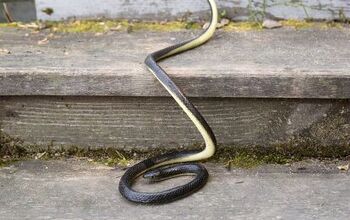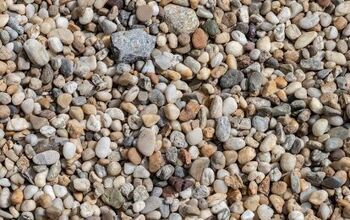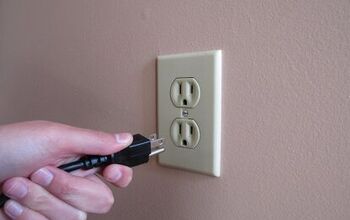How To Keep Snakes Out Of Your Greenhouse

A greenhouse lets homeowners expand their gardening capabilities and extend their growing season. However, a greenhouse can also attract many pests looking for shelter and food sources, including snakes. You’re not alone if you’ve ever wondered how to keep snakes out of your greenhouse.
The best way to keep snakes out of your greenhouse is to mow the surrounding lawn and keep the area clean. It’s also a good idea to seal the gaps and cracks in the greenhouse with caulk and put weatherstripping under the door. You can deter snakes if you spray your greenhouse with peppermint oil and eucalyptus.
Some people prefer commercial snake repellents, but it’s worth trying natural methods first. That way, you can keep your greenhouse chemical-free as much as possible. Follow along as we explore how to keep snakes out of your greenhouse.
How To Snake-Proof Your Greenhouse
Finding snakes in your greenhouse is equally terrifying and dangerous. You may not have venomous snakes where you live, but even non-venomous snakes can hurt you. The problem is that a greenhouse is a seemingly perfect environment for snakes.
However, these reptiles don’t realize that in most cases, your greenhouse lacks their favorite food sources. Unless your greenhouse is infested with mice, the snakes won’t have much to eat in there. Luckily, you can snake-proof your greenhouse using several simple methods, including:
1. Mow The Surrounding Grass
Is your greenhouse near the lawn? If so, that may explain why you find snakes in your greenhouse, and it’s a fixable issue. Snakes love overgrown lawns for several reasons, including the pests it attracts.
Mice and shrews often travel through tall grass, and snakes prey upon them. Snakes also travel through overgrown lawns to get to other food and water sources as needed. Many people build greenhouses on or near their lawns, and snakes sometimes find their way into them.
Keep your grass shorter than 3”, or else snakes and other critters may end up in the nearby greenhouse. Not only can shorter grass deter snakes, but it should also make the area around your greenhouse look better.
2. Get Rid Of Nearby Rodents
Snakes kill and eat rodents, but that’s not the only way that rodents can cause snake-related issues. The other problem is that rodents dig holes and burrow into the ground, and snakes often move into these holes. If such holes are anywhere near your greenhouse, there’s a chance that you’ll find snakes in your greenhouse.
Clean up the debris in your yard, mow the lawn, and remove food and water sources to deter rodents. That includes food bowls if you sometimes let your dog eat outside. In that case, start feeding your dog indoors until you get the rodent problem under control.
You can also call a pest control company to set up live traps or snap traps to get rid of the rodents. That way, snakes won’t have a food source, and they won’t have as many holes to burrow into near your greenhouse. If need be, you can also fill rodent holes in your yard as you find them.
3. Seal Your Greenhouse
Entering your greenhouse to water the plants and finding a snake is enough to give anyone a panic attack. That said, snakes will have problems entering your greenhouse if you seal every gap and crack. A snake can crawl through a very small gap, so you must seal even the thinnest cracks.
You can seal thin gaps with caulk in most cases, but you must make sure it’s weatherproof. That way, it won’t have a problem curing, and the elements won’t degrade it too quickly. It’s also a good idea to put weatherstripping at the base of the door to your greenhouse.
Not only will it keep snakes out, but it will also help prevent temperature loss, which is important during the winter. You can also seal the windows and vents with insect screens, which will deter insects and, by proxy, keep snakes out.
4. Embrace Snake Repellent Plants
You can repel snakes from your greenhouse using plants. Luckily, many snake repellent plants, such as marigolds, are quite visually appealing. Marigolds, rosemary, lemongrass, lavender, onions, garlic, and Mugwort can all deter snakes.
Catnip and mint also produce odors that are strong enough to repel snakes. However, you must consider that the odor radius isn’t necessarily too large. Because of that, it’s best to position these plants close to the doors and walls in your greenhouse.
That way, the snakes will hopefully detect the scent from outside your greenhouse. The worst-case scenario is that the snakes will enter your greenhouse, smell the plants, and leave. Be patient, as these plants may not repel snakes until they mature, which takes a while.
5. Use Commercial Snake Repellent
Going the natural route mentioned in the previous step is quite rewarding. However, it doesn’t yield results as quickly as using a commercial snake repellent. Commercial snake repellents are available at some home improvement and outdoor supply stores, and you can find them online.
They contain strong chemicals, like naphthalene, which can repel snakes. Mothballs contain naphthalene, but you must be careful when using them in your greenhouse. That’s because naphthalene is dangerous for humans and pets alike, so avoid it if your pets play in your greenhouse.
Some people even scatter some powdered sulfur around their greenhouse, as the smell deters snakes. That said, it’s worth considering using natural methods, like planting marigolds, as there is no downside. After all, many people want to keep their greenhouses chemical-free.
6. Clear The Surrounding Area
You will probably find many snakes in your greenhouse if it’s surrounded by groundcover plants, dense shrubs, and overgrown plants. Snakes are predators, so naturally, they like to hide and wait for their prey. That’s especially true in developed neighborhoods where they don’t have as much free rein as they’d like.
Ideally, you should clear several feet of space in front of and around your greenhouse. Trim the bushes, pull the weeds, and prune any overgrown plants that stand in the way. This can also give you some peace of mind, as you won’t have to wonder what’s hiding near your greenhouse.
During the fall, regularly collect the fallen leaves, so snakes don’t hide in the piles. However, you may want to keep the leaves and put them elsewhere. That way, you can support the pollinators and encourage them to come back strong in spring.
7. Spray The Area With Natural Oils
Planting marigolds and lavender can deter snakes, but using essential oils yields faster results. While you wait for the plants to mature, it’s worth spraying your greenhouse with some diluted essential oils. For example, you can dilute some peppermint oil in a spray bottle and spray the floors along the walls.
It’s also a good idea to spray the exterior walls and the doors with essential oils, so snakes don’t cross through. You can also soak some garlic cloves in a spray bottle for a few hours, then spray around your greenhouse.
Some people even spray their greenhouse perimeters and doors with cayenne pepper to deter snakes. However, you must be careful when using cayenne pepper and essential oils if you have pets. That’s because many essential oils, like peppermint, can harm dogs and cats.
8. Use An Ultrasonic Device
You’ve probably heard of ultrasonic pest repellent devices if you’ve ever had to ward off other scary pests from your greenhouse and yard. They emit unpleasant sounds that certain animals, like snakes, can hear, even though you can’t. Part of why they’re so popular is that ultrasonic devices don’t harm snakes or other animals, but they annoy them.
Annoying a snake to keep it out of your greenhouse is more ethical than burning them with chemicals. Your best bet is to put an ultrasonic pest repellent device in the soil outside of your greenhouse. While you could put one in your greenhouse, it probably isn’t necessary.
That’s because the device outside your greenhouse should repel snakes and rodents in equal measure. Even if the snakes don’t mind the sound, they’ll eventually leave because their food source, rodents, is gone.
Summing It Up
You can keep snakes out of your greenhouse by spraying the door and exterior walls with eucalyptus, cayenne pepper, and peppermint oil. It also helps to clear the debris and shrubs around your greenhouse, so the snakes have nowhere to hide. Take this opportunity to grow marigolds and garlic in your greenhouse, as they deter snakes and have many uses.
Related Guides:

Nick Durante is a professional writer with a primary focus on home improvement. When he is not writing about home improvement or taking on projects around the house, he likes to read and create art. He is always looking towards the newest trends in home improvement.
More by Nick Durante













![The 10 Best Table Saws - [2022 Reviews & Buyer's Guide]](https://cdn-fastly.upgradedhome.com/media/2023/07/31/9070645/the-10-best-table-saws-2022-reviews-buyer-s-guide.jpg?size=350x220)








![10 Most Dangerous Neighborhoods in Baltimore [Updated]](https://cdn-fastly.upgradedhome.com/media/2023/07/31/9075655/10-most-dangerous-neighborhoods-in-baltimore-updated.jpg?size=350x220)




